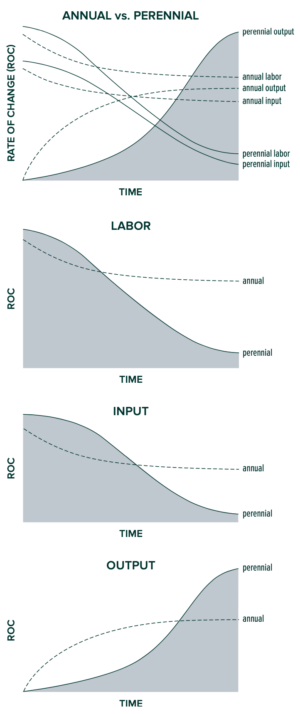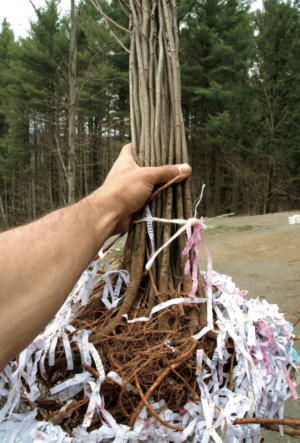
[ad_1]
Maintaining with a backyard will be loads of work; fortunately, there’s a secret weapon that can take away a few of your stress. Perennials are the proper addition to any backyard, and solely must be planted as soon as a decade!
The next is from The Resilient Farm and Homestead, Revised and Expanded Version by Ben Falk. It has been tailored for the online.
(The creator amid a guild of comfrey, wine cap mushrooms, clover, and dock below a cover of plum on the homestead {Photograph} by Brian Mohr/EmberPhoto.)

Annuals and perennials typically entail inverse labor enter and output relationships whereas perennial programs frequently enhance efficiency over time.
Rising Perennials
Perennial crops are rising to grow to be the bottom load engines of our regenerative land system on the Entire Programs Analysis Farm.
These everlasting producers solely should be established hardly ever—as soon as each couple of a long time to each century or three, relying on species—but they’ll produce yearly whereas constructing soil well being and requiring little or no fertility inputs.
As a result of perennials are established solely as soon as a decade or century in comparison with annuals, which have to be established as soon as yearly, they’re able to put extra power into bigger seed yields relative to annuals, which should spend a a lot larger proportion of their lifetime merely turning into established.
As well as, the roots of perennial crops inhabit deeper layers of the subsoil horizon with every passing 12 months.
A panorama coated in mantle of perennial crops has the capability to rework ever extra subsoil (mineral soil) into topsoil (organic-matter-rich materials) with every passing 12 months.
A panorama of annual crops capabilities solely to a really shallow layer—usually, the highest six to eighteen inches of the earth’s floor, relying on soil high quality, aridity, species, and different elements.
Many perennial crops penetrate two, three, six, twelve toes and even farther into the earth.
This rooting capability brings natural matter, water, and organic exercise—the idea for natural soil formation into the subsoil.
Once we harness this mechanism, perennial crops enable us to farm extra deeply the earth beneath our toes, thus doubling, tripling, or extra the quantity of mineral and different assets we’re in a position to attract on in our job of rising worth from the intersection of solar, soil, water, and dwelling organisms.
Not surprisingly, perennial-based programs equivalent to woodland/savannah system with three dimensions of crops, from grasses to shurbs to bushes, and grazing within the understory usually captures between three and 7 instances the quantity of photo voltaic power as a area of annual crops.
Perennials and Drought Resistance
Their means to develop deeply into the soil horizon permits perennials one other benefit, which is commonly their most vital benefit because the local weather turns into extra variable: drought resistance.
Deeper roots imply a a lot larger means to mine deeper water tables and moisture that evaporates from the floor downward. Many arid areas of the world have been made extra brittle and even created deserts due to an absence of satisfactory and acceptable perennial crops and disturbance mechanisms equivalent to farming, which has typically stocked the ecosystem with annuals.
Along with drought resistance, perennials supply a excessive diploma of flood resilience: They’ll typically face up to seasonal inundation (if not uncovered to high-flow velocities), whereas many annuals die or are rendered unusable (because of contamination) in the event that they go underwater.
Equally vital is perennials’ means to develop tall above the bottom, permitting us to farm extra vertical area into the environment.
This vertical tendency presents a complementary worth to the drought resistance achieved by their deep-rooting means: Perennials really harvest and improve the moisture out there in a web site and maintain moisture in through shading.
The flexibility of perennials, most notably bushes, to drag moisture out of humidity and to really promote cloud formation over a panorama via evapotranspiration and structural texturing is why a forested space all the time receives extra rainfall than the identical panorama in the identical area with out forest. That is why humanity has made many deserts via deforestation.

Fifty black locust seedlings—5 to fifteen cords of fuelwood inside about twenty years’ time. This tree presents by far the quickest return on funding on this local weather in the case of reworking sunshine into usable gasoline. Photograph courtesy of Ben Falk.
In a lot of the world, it may be clearly stated that “dropping our bushes means dropping our water.”
Shedding bushes, after all, additionally means dropping the buffering impact on large rainfalls and flooding as tree leaves cut back the erosive, percussive power of raindrops as they gradual, unfold, and sink floor water slightly than selling sheet move off the panorama and, consequently, disastrous flooding.
Haiti is without doubt one of the finest examples the world has to supply for deforestation begetting a variety of ecological and social programs failure: With the disappearance of tree cowl comes drought, flood, and big soil loss.
With these catastrophes come social system dysfunction—the historical past of people abusing land and ending up in a stricken society appears to bear this out repeatedly.
Perennials and Climate Circumstances
Together with moisture-harvesting skills are different microclimate-buffering capacities of a plant—or wall of crops—together with the flexibility to cut back drying and annoying winds; gradual and deposit snowfall, which is useful to tree, grass, and soil well being; and function solar traps, rising the radiant warmth out there in a panorama to advertise ripening of a crop and supply season-extended out of doors use areas for folks.
Associated to the vertical means of perennials is the sheer measurement and biomass potential of sure perennials.
You may’t flip any annual crop into gasoline or structural materials with out a number of processing to mix hundreds of smaller crops into one thing providing structural or power yields.
Bushes, then again, supply such yield of their uncooked kind—a woodland is a dwelling lumberyard that wants minimal processing to be helpful. A forest can also be a direct supply of gasoline that may also be of worth with little processing and power expenditure. You merely can’t get such yields with an annual plant.
Lastly, there may be an more and more vital benefit to perennials that’s simply turning into higher understood: Vegetation are likely to accumulate toxins most acutely of their vegetative tissue, not of their seeds.
Most perennials supply us an edible yield of seeds, nuts, or fruit, which accumulate much less poisonous buildup of metals and inorganic chemical substances.
This tendency additionally enhances perennials’ tendency to extra densely accumulate vitamins due largely to their inhabiting a wider spectrum of the soil horizon and accessing a better vary of vitamins in consequence, thus with the ability to make these vitamins out there to folks within the type of meals.
Why Are Perennials Essential?
To summarize, the causes perennial crop crops are a vital and foundational a part of a cold-climate panorama are various and embody the next:
- Excessive return on funding (ROI) in power, time, and supplies, as they’re solely planted a number of instances per century. This stems from a usually excessive growth-to-establishment ratio. This enables extra power to enter yields (replica, seeds, fruit) and fewer, proportionally in comparison with an annual, into the organism’s establishing itself.
- Deep soil penetration: Permitting us to construct extra soil and entry extra vitamins and water.
- Local weather resilience—drought and flood: A better means to each keep away from and bounce again from local weather stress, together with warmth, lack of water, and inundation.
- Microclimate enhancement: Moisture harvesting and holding, windbreak, snow fencing, solar traps.
- Structural yields: Timber, fencing, gasoline.
- Human well being enhancement: Toxicity avoidance and nutrient density—seeds and fruit are likely to accumulate toxins much less acutely than vegetative tissue, and perennials entry a wider vary of soil vitamins than annuals do.
Perennial Crop Disadvantages:
- Local weather: Many yields from a perennial crop depend on flower survival, which is turning into an ever better problem as world weirding produces early-season warmth waves, typically inflicting perennials to flower forward of their regular interval, damaging or destroying these flowers—and the fruit or nut crop they might yield (to not point out harming already confused pollinators).
- Breeding cycles/genetic agility: Some annuals enable a number of seed-production cycles per season, which permits quicker breeding of extra adaptive strains of crops that may improve their health because the local weather, pests, and atmospheric toxicity and different situations shift.
- Sluggish yield: Annuals may give us a big yield from seed inside months, not years and even a long time of seeding. Perennials by nature require an extended lead time to get established and supply yields. The one-two perennial-annual punch of rising loads of annuals whereas concurrently planting perennials is essential throughout web site institution.
- House: Merely requiring extra room by which to develop could be a draw back for folks dwelling in city or dense suburban areas.
Beneficial Reads
Find out how to Develop Wholesome Vegetation: Strengthening Your Farm or Backyard’s Immune System
[ad_2]